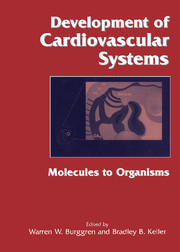Book contents
- Frontmatter
- Contents
- List of contributors
- Foreword by Constance Weinstein
- Introduction: Why study cardiovascular development?
- Part I Molecular, cellular, and integrative mechanisms determining cardiovascular development
- 1 Genetic dissection of heart development
- 2 Cardiac membrane structure and function
- 3 Development of the myocardial contractile system
- 4 Vasculogenesis and angiogenesis in the developing heart
- 5 Extracellular matrix maturation and heart formation
- 6 Endothelial cell development and its role in pathogenesis
- 7 Embryonic cardiovascular function, coupling, and maturation: A species view
- 8 Hormonal systems regulating the developing cardiovascular system
- Part II Species diversity in cardiovascular development
- Part III Environment and disease in cardiovascular development
- Epilogue: Future directions in developmental cardiovascular sciences
- References
- Systematic index
- Subject index
7 - Embryonic cardiovascular function, coupling, and maturation: A species view
from Part I - Molecular, cellular, and integrative mechanisms determining cardiovascular development
Published online by Cambridge University Press: 10 May 2010
- Frontmatter
- Contents
- List of contributors
- Foreword by Constance Weinstein
- Introduction: Why study cardiovascular development?
- Part I Molecular, cellular, and integrative mechanisms determining cardiovascular development
- 1 Genetic dissection of heart development
- 2 Cardiac membrane structure and function
- 3 Development of the myocardial contractile system
- 4 Vasculogenesis and angiogenesis in the developing heart
- 5 Extracellular matrix maturation and heart formation
- 6 Endothelial cell development and its role in pathogenesis
- 7 Embryonic cardiovascular function, coupling, and maturation: A species view
- 8 Hormonal systems regulating the developing cardiovascular system
- Part II Species diversity in cardiovascular development
- Part III Environment and disease in cardiovascular development
- Epilogue: Future directions in developmental cardiovascular sciences
- References
- Systematic index
- Subject index
Summary
Introduction: Scope and definitions
Many investigators have stated that structure and function are related during embryogenesis (Spranger et al., 1982; Clark, 1990). This common insight reflects centuries of investigation of developmental mechanisms using descriptive methods and through the testing of hypotheses related to biological interactions. Over this long period of time, much has been described regarding the basic physiologic parameters of circulating blood (or hemolymph) volume, heart rate (HR), and blood pressure and flow. Few, however, of the underlying mechanisms that determine these relationships have been defined. One explanation for the lack of fundamental insights into cardiovascular functional maturation is that most experimental protocols are designed and analyzed with respect to a single functional cardiac parameter (e.g., HR) of a single cardiac segment (e.g., atrium, ventricle, or vascular bed) (Keller, 1995).
Current research on the mature circulation supports the definition of the cardiovascular system as a closed system, where the input, function, and output of each of the elements are interrelated to accomplish cardiovascular regulation (Sunagawa, Sagawa, & Maughan, 1984). We still need to define embryonic cardiovascular function within an integrated, interactive framework to expose the fundamental mechanisms that regulate embryonic cardiovascular function and influence cardiovascular form. The goal of this chapter is to provide the reader with a multifaceted framework for the investigation, interpretation, and correlation of cardiovascular function during primary cardiovascular morphogenesis.
- Type
- Chapter
- Information
- Development of Cardiovascular SystemsMolecules to Organisms, pp. 65 - 87Publisher: Cambridge University PressPrint publication year: 1998
- 7
- Cited by



